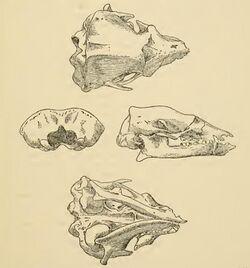Biology:Epoicotheriidae
| Epoicotheriidae | |
|---|---|

| |
| Artist reconstruction of Xenocranium pileorivale compared to the size of a human hand. | |

| |
| skull of Pentapassalus pearcei | |
| Scientific classification | |
| Domain: | Eukaryota |
| Kingdom: | Animalia |
| Phylum: | Chordata |
| Class: | Mammalia |
| Order: | †Palaeanodonta |
| Family: | †Epoicotheriidae Simpson, 1927[1] |
| Type genus | |
| †Epoicotherium Simpson, 1927
| |
| Genera[2] | |
|
[see classification]
| |
Epoicotheriidae ("strange beasts") is an extinct paraphyletic family of insectivorous placental mammals within extinct order Palaeanodonta, that lived in North America, Asia and Europe from the late Paleocene to early Oligocene.[2] Epoicotheriids were fossorial mammals. Late Eocene/early Oligocene genera were highly specialized animals that were convergent with the talpids, golden moles and marsupial mole in the structure of their skulls and forelimbs, and would have had a similar lifestyle as subterranean burrowers.[3]
Classification and phylogeny
Taxonomy
Epoicotheriidae was named by Simpson in 1927. It was assigned to the Palaeanodonta by Rose (1978)[4] and Carroll (1988).
Classification
- Family: †Epoicotheriidae (paraphyletic family) (Simpson, 1927)
- Genus: †Alocodontulum (Rose, 1978)
- †Alocodontulum atopum (Rose, 1977)
- Genus: †Amelotabes (Rose, 1978)
- †Amelotabes simpsoni (Rose, 1978)
- Genus: †Auroratherium (Tong & Wang, 1997)
- †Auroratherium sinense (Tong & Wang, 1997)
- Genus: †Dipassalus (Rose, 1991)
- †Dipassalus oryctes (Rose, 1991)
- Genus: †Tubulodon (Jepsen, 1932)
- †Tubulodon taylori (Jepsen, 1932)
- Subfamily: †Epoicotheriinae (paraphyletic subfamily) (Simpson, 1927)
- Genus: †Pentapassalus (Gazin, 1952)
- †Pentapassalus pearcei (Gazin, 1952)
- †Pentapassalus woodi (Guthrie, 1967)
- Genus: †Tetrapassalus (Simpson, 1959)
- †Tetrapassalus mckennai (Simpson, 1959)
- †Tetrapassalus proius (West, 1973)
- †Tetrapassalus sp. A [AMNH 10215] (Rose, 1978)
- †Tetrapassalus sp. B (Robinson, 1963)
- (unranked): †Epoicotherium/Xenocranium clade
- Genus: †Epoicotherium (Simpson, 1927)
- †Epoicotherium unicum (Douglass, 1905)
- Genus: †Molaetherium (Storch & Rummel, 1999)
- †Molaetherium heissigi (Storch & Rummel, 1999)
- Genus: †Xenocranium (Colbert, 1942)
- †Xenocranium pileorivale (Colbert, 1942)
- Genus: †Epoicotherium (Simpson, 1927)
- Genus: †Pentapassalus (Gazin, 1952)
- Genus: †Alocodontulum (Rose, 1978)
Phylogenetic tree
The phylogenetic relationships of family Epoicotheriidae are shown in the following cladogram:[5][6][7]
| Ferae |
|
Script error: No such module "Clade/labels". | |||||||||||||||||||||||||||||||||||||||||||||||||||||||||||||||||||||||||||||||||||||||||||||||||||||||||||||||||||||||||||||||||||||||||||||
See also
References
- ↑ G. G. Simpson (1927.) "In North American Oligocene edentate." Annals of Carnegie Museum 17 (2): 283-299
- ↑ Jump up to: 2.0 2.1 "Classification of the family Epoicotheriidae". Paleobiology Database. http://www.fossilworks.org/cgi-bin/bridge.pl?action=taxonInfo&taxon_no=43669&is_real_user=1.
- ↑ Kenneth D. Rose, Robert J. Emry (1983) "Extraordinary fossorial adaptations in the oligocene palaeanodonts Epoicotherium and Xenocranium (Mammalia)" Journal of Morphology 175(1):33 - 56
- ↑ Rose, Kenneth D. (1978). "A New Paleocene Epoicotheriid (Mammalia), with Comments on the Palaeanodonta". Journal of Paleontology 52 (3): 658–674.
- ↑ Kenneth D. Rose (2008). "Palaeanodonta and Pholidota". in Janis, Christine M; Gunnell, Gregg F; Uhen, Mark D. 9 - Palaeanodonta and Pholidota. pp. 135–146. doi:10.1017/CBO9780511541438.010. ISBN 9780511541438.
- ↑ Gaudin, Timothy (2009). "The Phylogeny of Living and Extinct Pangolins (Mammalia, Pholidota) and Associated Taxa: A Morphology Based Analysis". Journal of Mammalian Evolution (Heidelberg, Germany: Springer Science+Business Media) 16 (4): 235–305. doi:10.1007/s10914-009-9119-9. http://web2.utc.edu/~gvv824/Gaudin%20et%20al%202009.pdf. Retrieved 2020-08-28.
- ↑ Kondrashov, Peter; Agadjanian, Alexandre K. (2012). "A nearly complete skeleton of Ernanodon (Mammalia, Palaeanodonta) from Mongolia: morphofunctional analysis". Journal of Vertebrate Paleontology 32 (5): 983–1001. doi:10.1080/02724634.2012.694319. ISSN 0272-4634.
Wikidata ☰ Q4179279 entry
 |

